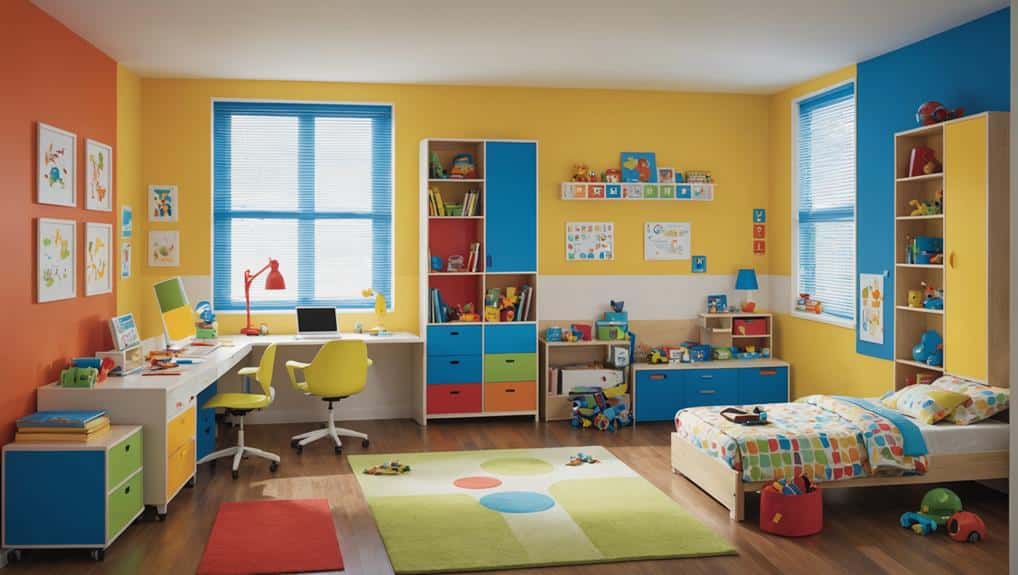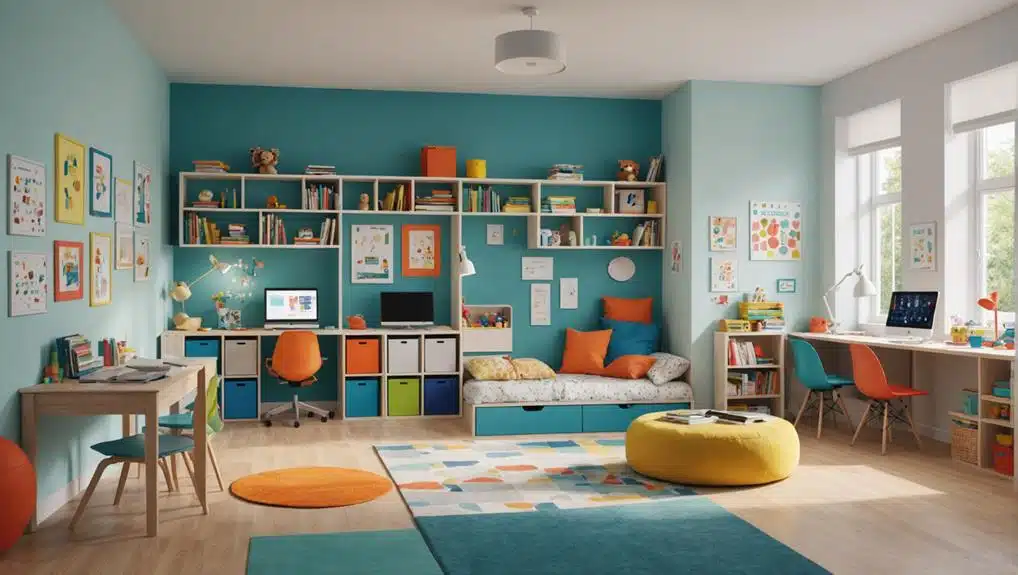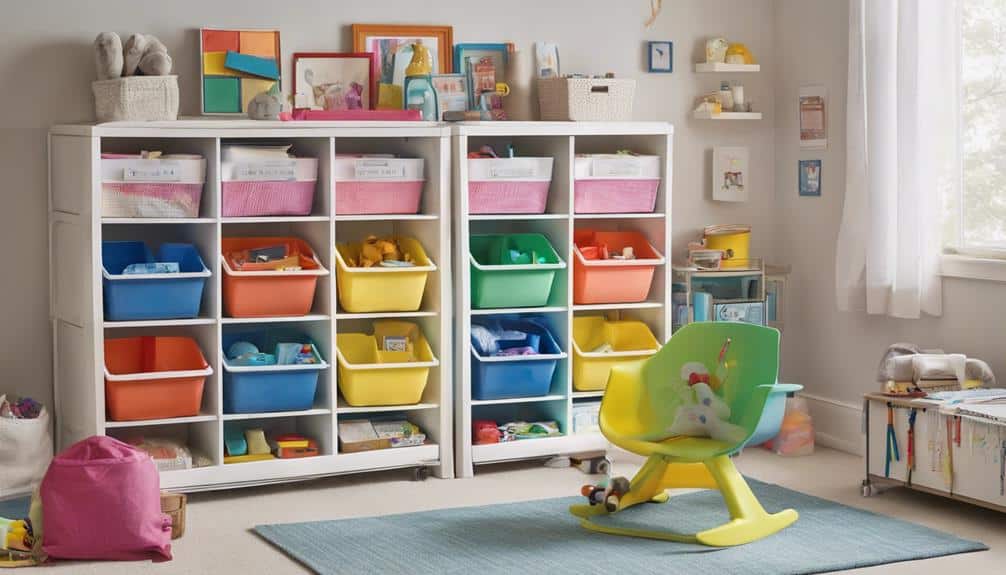Key Takeaways
- Establish consistent daily routines, including predictable meals, homework, and bedtime schedules to provide structure.
- Design a distraction-free, well-lit, comfortable space for focused activities using sensory integration techniques.
- Use visual aids like calendars and color-coded folders to promote organization and task management.
- Implement time management tools such as timers and alarms to enhance focus and cognitive performance.
- Create an ADHD-friendly home environment with soothing colors, reduced distractions, and visually aided arrangements.
Establishing Consistent Daily Routines
Establishing consistent daily schedules is the foundation of managing ADHD in children. This framework provides ADHD children with predictability that helps them thrive. Incorporating preferred tasks within these schedules can boost motivation and engagement, making the schedule more appealing and increasing compliance. Consistency in daily activities such as wake-up times, meals, homework, play, and bedtime forms the backbone of this schedule, serving as a bulwark against the uncertainty that can trigger anxiety and meltdowns.
Visual aids, like calendars and charts, are powerful tools for maintaining this schedule. They are constant reminders of what is scheduled for each day, assisting in keeping track of daily activities and transitions. Their objective clarity can benefit children with ADHD by offering a tangible representation of their day.
However, the key to these schedules working efficiently is adherence. The schedule must be followed diligently to create a structured environment that ADHD children can rely upon. The predictability provided by a steady timetable allows these children to stay focused, reduces their anxiety, and helps them stay organized. This consistent approach is essential to managing ADHD in children, fostering a sense of security and stability in their daily lives.
Organizing a Distraction-Free Space
One vital step in creating a structured home environment for a child with ADHD is arranging a space that is free from distractions. This area is for focused activities like homework, reading, or quiet play. It should be well-lit, comfortable, and contain all the supplies your child needs to work efficiently.
Incorporating sensory integration techniques, such as tailoring the space to match your child’s sensory preferences, can significantly improve their focus and productivity. Similarly, introducing a structured routine in this space can help decrease impulsivity and enhance concentration.
Eliminating excess clutter and distractions is crucial in crafting this organized environment. An orderly space can reduce visual distractions, helping your child to concentrate better. Noise-canceling headphones or white noise machines can also minimize auditory distractions, making it more straightforward for a child with ADHD to focus.
Incorporating visual aids like color-coded folders or labeled storage containers can help your child quickly locate and organize their materials. This aspect of the organization not only assists your child in maintaining an uncluttered workspace but also promotes responsibility and independence.
Utilizing Visual Schedules and Aids

Utilizing the power of visual schedules and aids can be game-changing for children with ADHD. These tools, which include written lists, picture schedules, and charts, provide a visual structure that helps reduce anxiety, understand changes, and anticipate tasks. They also foster a sense of independence, organization, and control, which are vital aspects of a structured environment for children with ADHD.
Moreover, besides these benefits, visual aids, much like assistive technology, can effectively support structured routines, schedules, and task management. They serve as constant, accessible reminders that can guide a child with ADHD through their day, enhancing executive functioning skills.
Visual aids are powerful tools for improving time management skills, a common challenge for kids with ADHD. By visually mapping out activities and tasks, these aids help children understand how time is organized and how activities fit into their day. This tangible representation of time and tasks can significantly reduce the stress and confusion of managing time.
Furthermore, the beauty of visual schedules is their adaptability; they can be tailored to fit each child’s needs and preferences. This personalization allows children to engage more fully with their schedules, leading to higher success rates.
Implementing Time Management Tools
Mastering the art of time management can be life-changing for children with ADHD. Time management tools such as timers, alarms, and clocks can play an essential role in helping these children stay on track with their tasks and responsibilities. These tools’ structured home environment can significantly improve their cognitive performance, task completion, and overall sense of well-being. This approach aligns with the concept of environmental adjustments, which create ADHD-friendly spaces for better focus.
Setting reminders is another effective method for managing time for children with ADHD. This practice assists them in shifting between tasks and serves as a regular prompt for their responsibilities. Doing so helps reduce the challenges these children often face with time perception and organization.
Furthermore, time-related interventions using behavioral practices are beneficial in managing ADHD symptoms effectively. Similar to evidence-based OT behavior strategies, these interventions enhance a child’s focus and are a substantial part of creating a structured home environment.
Designing an ADHD-Friendly Home Environment

Creating an ideal living setting for a child with ADHD can significantly enhance their ability to focus and manage their symptoms. Integrating structured routines, such as a consistent homework timetable or regular dinnertime, can foster productivity and family bonding, which is essential for a child with ADHD. A well-organized, physically and emotionally supportive setting can significantly assist in the child’s growth and ability to self-regulate.
Here are three key ways to design an ADHD-friendly home setting:
- Select soothing colors: Natural tones and cool blues encourage concentration and have a calming impact. This color palette can be particularly beneficial for children with ADHD, who often struggle with excessive stimuli.
- Reduce distractions: Limit toys and gadgets in common areas. A clutter-free setting minimizes distractions, aiding children with ADHD in better focus.
- Arrange with visual aids: Utilize shelves, tags, and other visual tools to establish a structured environment. These tools can assist in setting routines and expectations, which can be especially advantageous for children with ADHD.
Frequently Asked Questions
How to Structure a Home for an ADHD Child?
Creating a structured home for a child with ADHD involves establishing predictable routines, using visual aids, designating organized spaces, providing a distraction-free study area, and implementing time management tools to aid in task efficiency.
What Are the 5 C’s of ADHD Parenting?
The 5 C’s of ADHD parenting are Consistency, Calmness, Collaboration, Compassion, and Celebration. These principles guide effective parenting strategies and foster structure, serenity, teamwork, understanding, and positive reinforcement in the child’s home environment.
What Is the Best Environment for a Child With ADHD?
The ideal environment for a child with ADHD is organized and clutter-free, employing designated spaces, visual aids, and consistent routines. This structure aids focus, task completion, behavior management, and habit development.
What Is a Structured Environment for ADHD?
A structured environment for ADHD entails consistent routines, clear expectations, and organized spaces. It uses visual aids and designated areas to enhance focus, promoting security, self-regulation, and anxiety reduction for children with ADHD.
How can I maintain an ADHD-friendly environment as my child grows?
An ADHD-friendly environment should adapt as your child’s needs change. Regularly review routines, tools, and spaces to ensure they continue to support your child’s development and comfort.
Conclusion
Cultivating a disciplined, organized, and individualized habitat for children with ADHD can serve as a guide, illuminating their path toward self-regulation and well-being. By coordinating daily schedules, creating distraction-free areas, utilizing visual aids, and incorporating time management tools, the home transforms into a nurturing cocoon, fostering growth and development. Therefore, a structured setting is not just a layout of physical elements but a dynamic ecosystem that propels the child towards their maximum potential.


Recent Comments